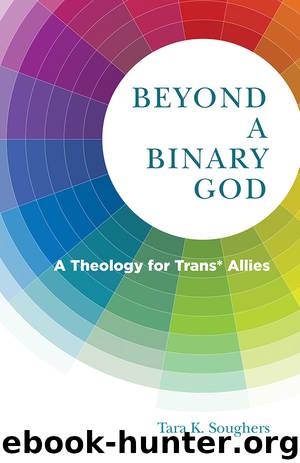Beyond a Binary God by Tara K. Soughers

Author:Tara K. Soughers
Language: eng
Format: epub
Publisher: Church Publishing Inc.
Published: 2018-04-18T04:00:00+00:00
Imago Dei and Genesis 1:26–28
Then God said, “Let us make humankind in our image, according to our likeness; and let them have dominion over the fish of the sea, and over the birds of the air, and over the cattle, and over all the wild animals of the earth, and over every creeping thing that creeps upon the earth.” So God created humankind in his image, in the image of God he created them; male and female he created them. God blessed them, and God said to them, “Be fruitful and multiply, and fill the earth and subdue it; and have dominion over the fish of the sea and over the birds of the air and over every living thing that moves upon the earth.” (Genesis 1:26–28)
As I mentioned earlier, this passage is often quoted by those who believe that one’s gender orientation has to match one’s anatomy. God created them male and female, and there is no mention of those who do not nicely fit into those two separate categories. It is also one of the primary passages used to argue for traditional gender roles for men and women: if both men and women are created in the image and likeness of God, then men and women bring different things to the understanding of God’s image and likeness. Therefore, men and women should both be honored, but neither is free to transgress their God-given roles. If they do, they are sinning. This position is held by many conservative religious groups among the Abrahamic traditions where questioning either the stability of gender or the necessity of rigid gender roles and expressions is not allowed. At the heart of the debate is what it means to be made both gendered and in the image of God.
Logically, those who most strongly argue for the complementarity of gender roles should be most open to the idea of God encompassing both male and female attributes. However, these are the very groups that fight most often against inclusive language and using metaphors for God that are not heavily masculine because indicating that men and women both are made in the image and likeness of God gives women an equality and an importance rarely found in these communities, or, frankly, in many places around the world. Men by themselves, however, do not fully image God, and therefore the use of only masculine images and pronouns necessarily shows an incomplete or a distorted image of God.
How is it that men and women—assuming that the two genders together image God better than each by itself—reveal the image of God? The question implies there are some distinguishable characteristics that each gender brings to our picture of God that are missing without their contribution. It asks us to look at how men and women are different. Most arguments about difference focus on either physical characteristics or roles.
Let us look at physical characteristics first. When a child is born, those attending the birth will look at the external genitalia to determine if the child is a boy or girl.
Download
This site does not store any files on its server. We only index and link to content provided by other sites. Please contact the content providers to delete copyright contents if any and email us, we'll remove relevant links or contents immediately.
| Anglican | Baptist |
| Book of Common Prayer | Calvinist |
| Episcopalian | Inspirational |
| Lutheran | Methodist |
| Pentecostal & Charismatic | Presbyterian |
| Quaker | Seventh-Day Adventist |
| Shaker | Theology |
Angels by Billy Graham(1889)
How To Be Born Again by Billy Graham(1732)
Peace with God by Billy Graham(1643)
Unbroken Curses by Rebecca Brown & Daniel Yoder(1521)
God's Prophetic Symbolism in Everyday Life by Adam Thompson & Adrian Beale(1447)
The School of Biblical Evangelism by Ray Comfort(1392)
Call by Rick Joyner(1369)
Martin Luther: The Man Who Rediscovered God and Changed the World by Eric Metaxas(1354)
Power over the Enemy by John Osteen & Joel Osteen(1316)
Jonathan Edwards: A Life by Marsden George M(1195)
Fresh Wind, Fresh Fire by Jim Cymbala(1191)
Prayers That Bring Healing and Activate Blessings: Experience the Protection, Power, and Favor of God by John Eckhardt(1189)
Liturgy of the Ordinary by Tish Harrison Warren(1182)
The Supernatural Power of a Transformed Mind Expanded Edition: Access to a Life of Miracles by Bill Johnson(1173)
Unmasking the Devil: Strategies to Defeat Eternity's Greatest Enemy by John Ramirez(1162)
An Altar in the World by Barbara Brown Taylor(1154)
Reformation Theology by Littlejohn Bradford(1146)
Seeing the Voice of God: What God Is Telling You through Dreams and Visions by Smith Laura Harris(1104)
Martin Luther by Mansch Larry D.; Peters Curtis H.;(1104)
